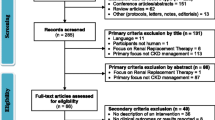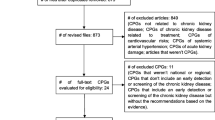Abstract
Background
The prevalence of chronic kidney disease (CKD) has recently increased, and maintaining high quality of CKD care is a major factor in preventing end-stage renal disease. Here, we developed novel quality indicators for CKD care based on existing electronic health data.
Methods
We used a modified RAND appropriateness method to develop quality indicators for the care of non-dialysis CKD patients, by combining expert opinion and scientific evidence. A multidisciplinary expert panel comprising six nephrologists, two primary care physicians, one diabetes specialist, and one rheumatologist assessed the appropriateness of potential indicators extracted from evidence-based clinical guidelines, in accordance with predetermined criteria. We developed novel quality indicators through a four-step process: selection of potential indicators, first questionnaire round, face-to-face meeting, and second questionnaire round.
Results
Ten expert panel members evaluated 19 potential indicators in the first questionnaire round, of which 7 were modified, 12 deleted, and 4 newly added during subsequent face-to-face meetings, giving a final total of 11 indicators. Median rate of these 11 indicators in the final set was at least 7, and percentages of agreement exceeded 80 % for all but one indicator. All indicators in the final set can be measured using only existing electronic health data, without medical record review, and 9 of 11 are process indicators.
Conclusion
We developed 11 quality indicators to assess quality of care for non-dialysis CKD patients. Strengths of the developed indicators are their applicability in a primary care setting, availability in daily practice, and emphasis on modifiable processes.
Similar content being viewed by others
References
Imai E, Horio M, Nitta K, Yamagata K, Iseki K, Hara S, et al. Estimation of glomerular filtration rate by the MDRD study equation modified for Japanese patients with chronic kidney disease. Clin Exp Nephrol. 2007;11:41–50.
Coresh J, Selvin E, Stevens LA, et al. Prevalence of chronic kidney disease in the US. JAMA. 2007;298:2038–47.
Couser WG, Remuzzi G, Mendis S, Tonelli M. The contribution of chronic kidney disease to the global burden of major noncommunicable diseases. Kidney Int. 2011;80:1258–70.
Collins AJ, Foley RN, Herzog C, Chavers B, Gilbertson D, Herzog C, et al. US Renal Data System 2012 annual data report. Am J Kidney Dis. 2013;61:A7.
Fox CH, Brooks A, Zayas LE, McClellan W, Murray B. Primary care physicians’ knowledge and practice patterns in the treatment of chronic kidney disease: an Upstate New York Practice-based Research Network (UNYNET) Study. J Am Board Fam Med. 2006;19:54–61.
Mainz J. Defining and classifying clinical indicators for quality improvement. Int J Qual Health Care. 2003;15:523–30.
Rubin HR, Pronovost P, Diette GB. Methodology matters. From a process of care to a measure: the development and testing of a quality indicator. Int J Qual Health Care. 2001;13:489–96.
Dreischulte T, Grant AM, McCowan C, McAnaw JJ, Guthrie B. Quality and safety of medication use in primary care: consensus validation of a new set of explicit medication assessment criteria and prioritisation of topics for improvement. BMC Pharmacol Toxicol. 2012;12:5.
Donabedian A. The quality of care: how can it be assessed? JAMA. 1988;260:1743–8.
To T, Guttmann A, Lougheed MD, Gershon AS, Dell SD, Stanbrook MB, et al. Evidence-based performance indicators of primary care for asthma: a modified RAND appropriateness method. Int J Qual Health Care. 2010;22:476–85.
CKD Guideline Editorial Committee. Evidence-based practice guideline for the treatment of CKD. Clin Exp Nephrol. 2009;13:537–66.
Lankhorst CE, Wish JB. Anemia in renal disease: diagnosis and management. Blood Rev. 2010;24:39–47.
Locatelli F, Aljama P, Barany P, Canaud B, Carrera F, Eckardt KU, et al. Revised European best practice guidelines for the management of anaemia in patients with chronic renal failure. Nephrol Dial Transplant. 2004;19:ii1–47.
Locatelli F, Pisoni RL, Akizawa T, Cruz JM, DeOreo PB, Lameire NH, et al. Anemia management for hemodialysis patients: kidney disease outcomes quality initiative (K/DOQI) guidelines and dialysis outcomes and practice patterns study (DOPPS) findings. Am J Kidney Dis. 2004;44:27–33.
Campbell SM, Braspenning J, Hutchinson A, Marshall MN. Research methods used in developing and applying quality indicators in primary care. BMJ. 2003;326:816–9.
Avery AJ, Dex GM, Mulvaney C, Serumaga B, Spencer R, Lester HE, et al. Development of prescribing-safety indicators for GPs using the RAND appropriateness method. Br J Gen Pract. 2011;61:e526–36.
Fitch K, Bernstein SJ, Aguilar MD, Burnand B, LaCalle JR. The RAND/UCLA Appropriateness method user’s manual. 2001.
Minutolo R, De Nicola L, Mazzaglia G, Postorino M, Cricelli C, Mantovani LG, et al. Detection and awareness of moderate to advanced CKD by primary care practitioners: a cross-sectional study from Italy. Am J Kidney Dis. 2008;52:444–53.
Jones C, Roderick P, Harris S, Rogerson M. An evaluation of a shared primary and secondary care nephrology service for managing patients with moderate to advanced CKD. Am J Kidney Dis. 2006;47:103–14.
Richards N, Harris K, Whitfield M, O’Donoghue D, Lewis R, Mansell M, et al. Primary care-based disease management of chronic kidney disease (CKD), based on estimated glomerular filtration rate (eGFR) reporting, improves patient outcomes. Nephrol Dial Transplant. 2008;23:549–55.
Fox CH, Swanson A, Kahn LS, Glaser K, Murray BM. Improving chronic kidney disease care in primary care practices: an Upstate New York Practice-based Research Network (UNYNET) Study. J Am Board Fam Med. 2008;21:522–30.
de Vos M, Graafmans W, Kooistra M, Meijboom B, Van Der Voort P, Westert G. Using quality indicators to improve hospital care: a review of the literature. Int J Qual Health Care. 2009;21:119–29.
Safran C, Bloomrosen M, Hammond WE, Labkoff S, Markel-Fox S, Tang PC, et al. Toward a national framework for the secondary use of health data: an American Medical Informatics Association White Paper. J Am Med Inform Assoc. 2007;14:1–9.
Laine C. Coming to grips with large databases. Ann Intern Med. 1997;127:645–7.
Iezzoni LI. Assessing quality using administrative data. Ann Intern Med. 1997;127:666–74.
Zhan C, Miller MR. Administrative data based patient safety research: a critical review. Qual Saf Health Care. 2003;12:ii58–63.
Johantgen M, Elixhauser A, Bali JK, Goldfarb M, Harris DR. Quality indicators using hospital discharge data: state and national applications. Jt Comm J Qual Improv. 1998;24:88–105.
Farquhar M. AHRQ Quality indicators. 2008. http://www.ncbi.nlm.nih.gov/books/NBK2664/. Accessed 7 Dec 2015.
Chassin MR, Loeb JM, Schmaltz SP, Wachter RM. Accountability measures—using measurement to promote quality improvement. N Engl J Med. 2010;363:683–8.
Chapin E, Zhan M, Hsu VD, Seliger SL, Walker LD, Fink JC. Adverse safety events in chronic kidney disease: the frequency of “multiple hits”. Clin J Am Soc Nephrol. 2010;5:95–101.
Quality and Outcomes Framework Indicators. Standards and Indicators NICE [Internet]. https://www.nice.org.uk/standards-and-indicators/qofindicators. Accessed 10 Feb 2016.
Kotter T, Blozik E, Scherer M. Methods for the guideline-based development of quality indicators—a systematic review. Implement Sci. 2012;7:21.
Japanese Society of Nephrology [Internet]. http://www.jsn.or.jp/en/. Accessed 11 Feb 2016.
Weiner DE, Tabatabai S, Tighiouart H, Elsayed E, Bansal N, Griffith J, et al. Cardiovascular outcomes and all-cause mortality: exploring the interaction between CKD and cardiovascular disease. Am J Kidney Dis. 2006;48:392–401.
Bello A, Padwal R, Lloyd A, Hemmelgarn B, Klarenbach S, Manns B, et al. Using linked administrative data to study periprocedural mortality in obesity and chronic kidney disease (CKD). Nephrol Dial Transplant. 2013;28:iv57–64.
Acknowledgments
This work was supported by JSPS KAKENHI Grant Number 23390130. We are particularly grateful for the assistance given by Miho Kimachi (Kyoto University) who contributed to guideline review.
Author information
Authors and Affiliations
Corresponding author
Ethics declarations
Conflict of interest
Consultancies: Shingo Fukuma (Kyowa Hakko Kirin), Motoko Yanagita (Astellas), Shunichi Fukuhara (Kyowa Hakko Kirin), Masaomi Nangaku (Kyowa Hakko Kirin, Taisho, GSK, Tanabe-Mitsubishi, Takeda, Astellas, JT), Yugo Shibagaki (Asteras Pharma), Honoraria: Masaomi Nangaku (Kyowa Hakko Kirin, Daiichi-Sankyo, MSD, AstraZeneca, Alexion, GSK, Tanabe-Mitsubishi, Taisho, Chugai, Takeda, Astellas, JT, Bayer, Medical Review), Yugo Shibagaki (Novartis Pharma, Otsuka Pharmaceuticals, Kyowa Hakko Kirin). Sayaka Shimizu, Kakuya Niihata, Ken-ei Sada, Tsuguru Hatta, Ritsuko Katafuchi, Yoshihiro Fujita, Junji Koizumi, Shunzo Koizumi and Kenjiro Kimura have declared no competing interest.
Funding
Yugo Shibagaki (Teijin Pharma, Otsuka Pharmaceuticals, Kyowa Hakko Kirin, Takeda Pharmaceuticals, Baxter Japan, Behringer-Ingelheim, Astrazeneca, Sanwa Chemical), Motoko Yanagita (Astellas, Chugai, Daiichi Sankyo, Fujiyakuhin, Kyowa Hakko Kirin, Mitsubishi Tanabe, MSD, Nippon Boehringer Ingelheim, and Torii), Masaomi Nangaku (Alexion, Kyowa Hakko Kirin, Daiichi-Sankyo, Astellas, Tanabe-Mitsubishi, Takeda).
About this article
Cite this article
Fukuma, S., Shimizu, S., Niihata, K. et al. Development of quality indicators for care of chronic kidney disease in the primary care setting using electronic health data: a RAND-modified Delphi method. Clin Exp Nephrol 21, 247–256 (2017). https://doi.org/10.1007/s10157-016-1274-8
Received:
Accepted:
Published:
Issue Date:
DOI: https://doi.org/10.1007/s10157-016-1274-8




